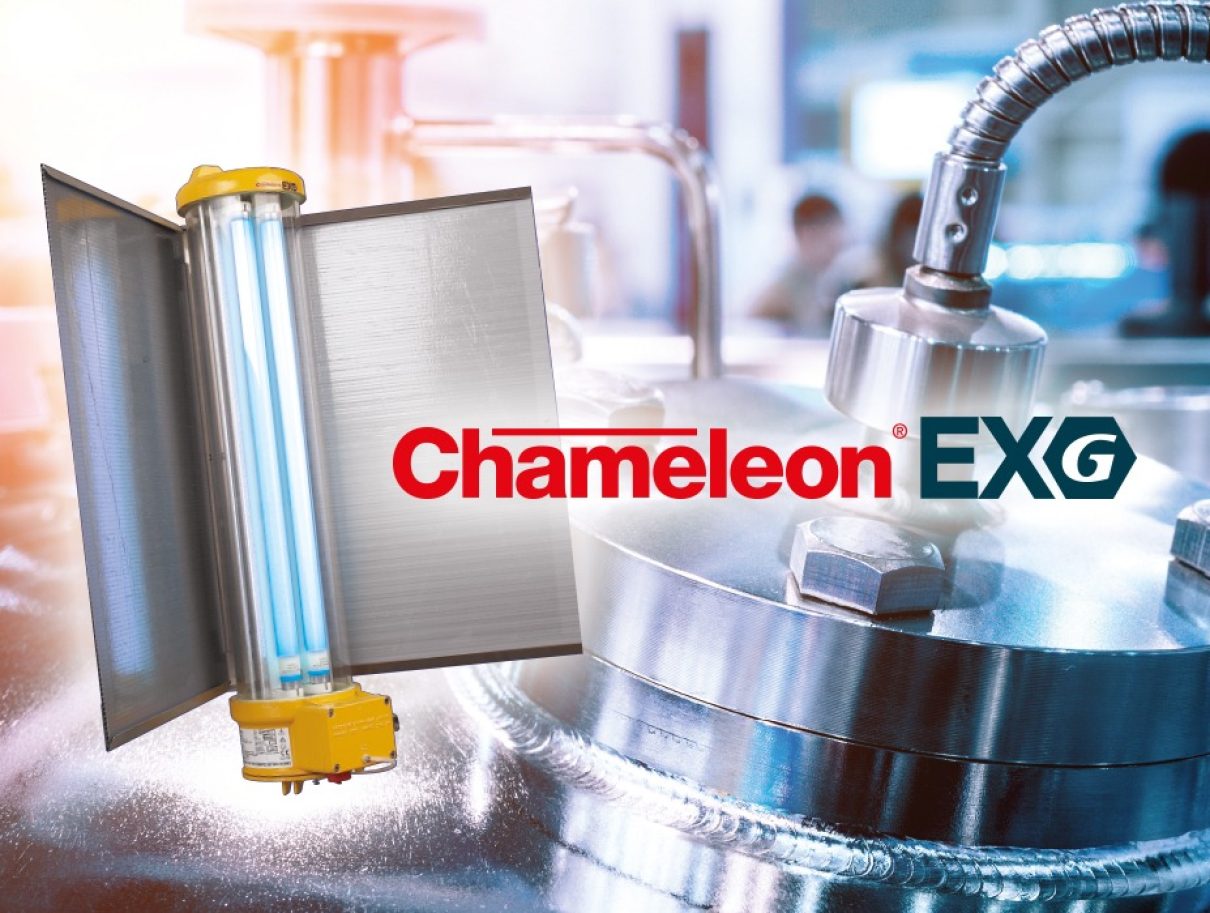With increased frequency, pest controllers will be asked to install UV fly control units in hazardous areas, potentially explosive areas in particular.
So, how can you be sure to use the right units for such critical zones? To satisfy the requirements of the ATEX Directive, PestWest has specialised in manufacturing two suitable UV fly control units for areas which can be subject to explosion hazards: Chameleon® EXG and Chameleon® 4×4 EX.
These units operate on the principle that most flying insects are attracted to light, particularly to the ultraviolet (UV) end of the light spectrum. This light is invisible to humans, however, the lamps glow blue which indicates that they are functional. The flying insects will be caught on a sticky board. For obvious reasons, the use of EFKs which can be liable for the cause of ignition sparks, is not permitted in potentially explosive areas.
Electrical equipment is potentially dangerous in areas where flammable gases, vapours or suspended dust particles come into contact with air, creating a potentially explosive atmosphere. An explosion will occur if these three elements combine:
- Oxygen (in the air)
- Flammable substance (Gas, vapour or dust)
- Ignition Source (flame, spark, electric arc, high temperature)
There are various substances that are categorised as potentially explosive, especially in food manufacturing and the pharmaceutical industry. This includes gas or vapours of solvents, alcohol, powder or dust of cornflour, wheat flour, milk and sugar. As a consequence, there is a potential danger of explosion in areas where these substances are produced, processed or stored.
Under normal circumstances, an explosion-prone area isn’t explosive, however, it can become explosive if there is e.g. a spark occurring or a unit overheating. Therefore, the usage of electrical devices might become dangerous. For this reason, it’s vital that electronical equipment which is going to be used in a potentially explosive environment, does comply with the ATEX Directive.
ATEX is the name commonly given to the two European Directives for controlling explosive atmospheres:
- Directive 99/92/EC (also known as ‘ATEX 137’ or the ‘ATEX Workplace Directive’) on minimum requirements for improving the health and safety protection of workers potentially at risk from explosive atmospheres.
- Directive 94/9/EC (also known as ‘ATEX 95’ or ‘the ATEX Equipment Directive’) on the approximation of the laws of EU member states concerning equipment and protective systems intended for use in potentially explosive atmospheres.
Employers must classify areas where hazardous explosive atmospheres may occur into zones. The classification given to a particular zone, and its size and location, depends on the likelihood of an explosive atmosphere occurring and its persistence if it does:
Definition of ATEX ZONES
| Gas | Dust | Definition |
|---|---|---|
| 0 | 20 | Areas in which an explosive atmosphere is present continuously or for long periods or frequently. |
| 1 | 21 | Areas in which an explosive atmosphere is likely to occur in normal operation occasionally. |
| 2 | 22 | Areas in which an explosive atmosphere is not likely to occur in normal operation but, if it does occur, will persist for a short period only. |
Before a workplace containing zoned areas comes into operation for the first time, the employer must ensure that the overall explosion safety measures are verified as being safe. Further, the employer’s risk assessment must ensure the following:
- Assessment of explosion hazard
- Guarantee of workplace safety
- Potentially explosive areas need to be categorised correctly.
This must be done by a person or organisation competent to consider the particular risks in the workplace, and the adequacy of the explosion control and other measures put in place.
Additionally, equipment and protective systems intended to be used in zoned areas should be selected to meet these requirements.
Electrical devices with ATEX certification can also be divided into categories relating to their equipment group code:
| Gas & vapour | Dust | Presence of explosive atmosphere | ||
|---|---|---|---|---|
| 0 | 1 G | 20 | 1 D | Likely |
| 1 | 2 G | 21 | 2 D | Occasionally |
| 2 | 3 G | 22 | 3 D | Barely/ short-term |
The Chameleon® 4x4EX is ATEX rated, suitable for use in potentially explosive atmospheres and is marked II 3 D Ex tc IIIC T105 IP65. Further, it’s suitable for the use in Zone 22 classified areas, i.e.: sugar factories and flour mills. An additional protective measure is that the surface temperature of the chassis won’t exceed 105°C.
The Chameleon® EXG is suitable for Zone 1, Zone 21, Zone 2 and Zone 22 areas where there may be potential for explosive atmospheres in the form of gases and vapours or dust, i.e.: Alcohol distilleries, sugar factories and flour mills. One of the main protection features of the Chameleon® EXG is its fire resistance, meaning that the unit can withstand an internal explosion without transmitting it onto its surrounding area. In addition, the Chameleon® EXG also has an IP66 rating due to a total anti-corrosive construction including 304 brushed stainless steel, marine grade aluminium alloy and a 7mm thick borosilicate glass enclosure.
In conclusion, all EX-ratings are not created equal. Therefore, it’s vital to rely on independently certified quality units of trustworthy manufacturers like PestWest so that your clients will be in safe hands!













